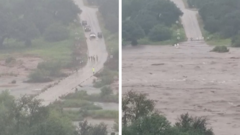
Rapid Rise: Llano River Swells Dramatically in One Hour
Recent footage has captured the astonishing speed at which the Llano River experienced a significant surge in water levels. The video, taken over the course of just one hour, vividly illustrates the river's dramatic transformation from its normal state to a rapidly rising torrent. This rapid increase has prompted concerns about potential flooding and its impact on nearby communities and ecosystems.
Witnessing the Unfolding Event
The captured footage provides a stark visual representation of the escalating situation. What initially appears to be a normal flow of water quickly evolves into a powerful and expanding body of water, encroaching upon its banks and surrounding areas. The rapid pace of this change underscores the importance of understanding and preparing for such events.
Factors Contributing to the Rapid Rise
While the footage clearly documents the event, understanding the underlying causes is crucial for effective mitigation and prevention. Several factors could contribute to such a rapid rise in river levels:
- Intense Rainfall: Heavy and sustained rainfall in the river's drainage basin is a primary driver of increased water volume. Even localized downpours can dramatically affect water levels downstream.
- Upstream Releases: Controlled or uncontrolled releases from dams or reservoirs located upstream can significantly contribute to a surge in river flow.
- Soil Saturation: When the ground is already saturated from previous rainfall, it loses its capacity to absorb additional water, leading to increased runoff into the river.
- Topography: The shape and slope of the surrounding terrain can influence how quickly rainwater flows into the river system. Steep slopes encourage faster runoff, exacerbating the problem.
- Vegetation Cover: Sparse vegetation cover can reduce the amount of water absorbed by the ground, increasing the likelihood of rapid runoff.
Potential Impacts of the Flooding
The sudden rise in the Llano River poses a range of potential threats to the environment and human populations:
- Property Damage: Homes, businesses, and infrastructure located near the river are at risk of inundation, leading to costly repairs and potential displacement of residents.
- Erosion and Sedimentation: The force of the water can erode riverbanks, destabilizing the surrounding land and increasing sediment deposits downstream, which can impact water quality.
- Disruption of Transportation: Flooding can close roads and bridges, disrupting transportation networks and hindering emergency services.
- Impact on Wildlife: Flooding can destroy habitats and displace wildlife, disrupting ecosystems and impacting biodiversity.
- Water Contamination: Floodwaters can carry pollutants and contaminants from agricultural runoff, industrial sites, and sewage systems, posing risks to human health and the environment.
Community Preparedness and Safety Measures
Given the potential dangers associated with rapid river rises, it is imperative that communities take proactive steps to prepare for and mitigate the risks. This includes:
- Monitoring Weather Conditions: Staying informed about weather forecasts and potential rainfall events is essential for early warning and preparation.
- Flood Warning Systems: Implementing and maintaining effective flood warning systems can provide timely alerts to residents in affected areas.
- Emergency Evacuation Plans: Developing and practicing emergency evacuation plans can ensure that residents know how to safely evacuate their homes in the event of flooding.
- Flood Insurance: Obtaining flood insurance can provide financial protection against property damage caused by flooding.
- Protecting Critical Infrastructure: Implementing measures to protect critical infrastructure, such as water treatment plants and power stations, from flooding can minimize disruptions to essential services.
Long-Term Solutions and Prevention
In addition to immediate preparedness measures, long-term solutions are needed to address the underlying causes of rapid river rises and mitigate the risks of flooding. These solutions may include:
- Watershed Management: Implementing sustainable watershed management practices, such as reforestation and soil conservation, can improve water infiltration and reduce runoff.
- Floodplain Management: Restricting development in floodplains and preserving natural flood storage areas can minimize property damage and protect ecosystems.
- Infrastructure Improvements: Upgrading drainage systems and building flood control structures, such as levees and dams, can help to manage floodwaters.
- Climate Change Mitigation: Reducing greenhouse gas emissions can help to mitigate climate change, which is expected to increase the frequency and intensity of extreme weather events, including heavy rainfall and flooding.
The rapid rise of the Llano River serves as a powerful reminder of the dynamic forces of nature and the importance of being prepared. By understanding the causes, potential impacts, and available solutions, communities can take proactive steps to protect themselves and their environment from the devastating effects of flooding.
```